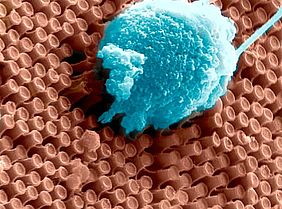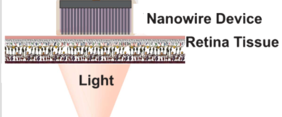Technology has made amazing progress towards the creation of the artificial eye. In 2013 ARGUS II, the first "artificial eye" (a retinal implant converting light into electrical pulses to stimulate retinal neurones disabled by retinitis pigmentosa to send signals to the brain) was approved by FDA as a humanitarian device. Although it has been shown to help it is still a far cry from restoring vision. The implant consists of a 60 electrodes array, each measuring 200 µm in diameter. In a way it is like saying that it can provide a 60 pixel resolution, very very little if you compare to the millions of receptors in a normal human eye.
Now researchers at the University of California in San Diego have managed to nano-engineer a retinal implant whose electrodes are made by nanotubes. Each nanotube acts like a light sensor, detecting light and transforming it into an electrical impulse to stimulate retinal nerve terminations. The "resolution" is greatly improved. Each silicon nanowire is 1µm in diameter and this roughly correspond to the same density of photoreceptors in our retina (several thousands fold increase in resolution with respect to ARGUS II).
Notice that to achieve a resolution that provides the minimum "legal" acuity (20/200) the resolution should be in the order of 50µm (16 times better than ARGUS II). Achieving a perfect acuity, 20/20, requires a resolution of 5µm, hence this nano-engineered implant can potentially deliver perfect sight.
The implant is powered wirelessly through an external coil placed on the side of the eye. That same coil provides power to the implant and the data to convert into electrical stimulation. The implant is able to use up to 90% of the power transmitted. This energy efficiency is crucial to decrease the heat generated, a big issue in implants since heat is harmful to cells.
A Start up, Nanovision Bioscience, has been created to further the studies and move into clinical trials, first with animals and hopefully to humans in the next decade. So far testing has taken place on rat's retina in vitro.








